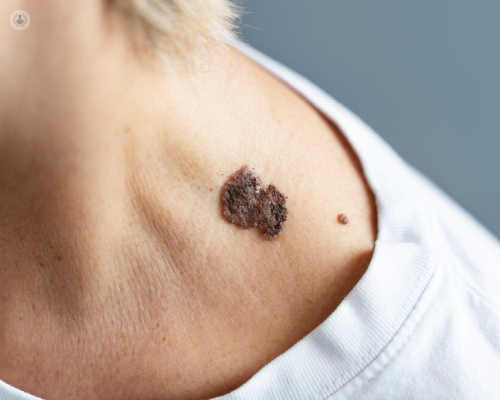From cosmetic to medical: understanding the different reasons for mole removal
Written in association with:Moles are common skin growths that most people have at some point in their lives. While many moles are harmless, some may require removal for cosmetic or medical reasons.
What are the different types of moles?
Moles, or nevi, are growths on the skin made up of clusters of pigment cells known as melanocytes. They can vary in colour, shape, and size. Here are some common types:
- Congenital moles: these are present at birth and can vary in size.
- Common moles: these develop in early childhood or adolescence and are usually smaller than 5mm in diameter. They are generally uniform in shape and colour.
- Atypical or dysplastic moles: these may have an irregular shape, uneven colour, or be larger than typical moles. Atypical moles can resemble melanoma and may need closer monitoring.
Most moles are benign, meaning they are not cancerous, but any changes in appearance should be checked by a doctor.
What are the medical reasons for mole removal?
The primary medical reason for mole removal is the suspicion of skin cancer, particularly melanoma. A doctor may recommend removing a mole if it shows any of the following concerning signs:
- Changes in size, shape, or colour: moles that grow rapidly, have irregular edges, or change in pigmentation could be signs of melanoma.
- Itching or bleeding: if a mole becomes itchy, starts to bleed, or develops a scab, it is essential to have it examined.
- Pain or tenderness: moles that are painful or sensitive to touch may require evaluation.
- Location-related irritation: some moles can become irritated due to friction or pressure from clothing, especially in areas such as the waistband, underarms, or bra line.
In these cases, your doctor may recommend a biopsy to determine if the mole is cancerous or pre-cancerous. If a mole is diagnosed as melanoma, it will need to be surgically removed.
Can moles be removed for cosmetic reasons?
Yes, mole removal is often performed for cosmetic purposes. While many people are comfortable with their moles, others may find them unsightly, particularly if they are on visible areas such as the face or neck. Cosmetic mole removal is generally a straightforward procedure that can be done to improve appearance or self-confidence.
Before undergoing cosmetic mole removal, it is important to consult with a doctor to ensure the mole is benign and that the removal procedure will leave minimal scarring.

What are the different methods of mole removal?
Several techniques can be used to remove moles, depending on their size, type, and the reason for removal. Here are the most common methods:
- Shave excision: for smaller, raised moles, a doctor can shave off the mole with a surgical blade. This method is often used for cosmetic mole removal as it usually leaves minimal scarring.
- Excisional surgery: if a mole needs to be completely removed, particularly for medical reasons, excisional surgery is performed. The mole and a small margin of surrounding skin are cut out, and the wound is stitched closed.
- Laser removal: some moles, especially those that are flat or in difficult-to-reach areas, can be removed with a laser. This method is mainly used for cosmetic purposes and may require several sessions.
- Cryotherapy: cryotherapy uses liquid nitrogen to freeze and remove small moles or other skin lesions. It is less commonly used for mole removal but may be an option for certain cases.
The method of removal will depend on the size and location of the mole, as well as the reason for removal. Your doctor will advise the most appropriate treatment option.
Are there risks associated with mole removal?
Mole removal is generally a safe procedure, but like any surgical intervention, it carries some risks. Potential risks include:
- Scarring: while doctors take care to minimise scarring, the extent of scarring depends on the mole's size and the removal technique used. Shave excision and laser removal typically result in less noticeable scars than excisional surgery.
- Infection: as with any procedure that breaks the skin, there is a small risk of infection. Proper aftercare, such as keeping the wound clean and following your doctor’s instructions, reduces this risk.
- Bleeding: some minor bleeding may occur, especially with larger or deeper moles.
- Recurrence: in rare cases, a mole may grow back after removal, particularly if any part of the mole’s cells remains.
Your doctor will discuss these risks with you during your consultation and ensure that you are fully informed before the procedure.
What should I expect during recovery?
The recovery period following mole removal varies depending on the method used and the size of the mole. Generally, the healing process takes around 1 to 2 weeks.
- Shave excision: the area may scab over and heal within a few days. Scarring is usually minimal.
- Excisional surgery: you may have stitches, which will need to be removed after a week or two. The wound may take longer to heal fully, and there may be some scarring.
- Laser removal: the area will likely heal quickly, but it may take multiple sessions to remove larger moles entirely.
Aftercare instructions typically include keeping the area clean, avoiding sun exposure, and monitoring for any signs of infection. It is important to follow your doctor’s advice to ensure proper healing.
Whether for medical or cosmetic reasons, mole removal is a routine and generally safe procedure. Regular skin checks and being aware of changes in your moles can help identify potential issues early, particularly with regard to skin cancer. If you have concerns about a mole, consult a doctor to assess the best course of action, whether for cosmetic improvement or medical necessity.


